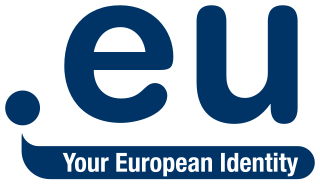Related Research Articles

In the Internet, a domain name is a string that identifies a realm of administrative autonomy, authority or control. Domain names are often used to identify services provided through the Internet, such as websites, email services and more. As of 2017, 330.6 million domain names had been registered. Domain names are used in various networking contexts and for application-specific naming and addressing purposes. In general, a domain name identifies a network domain or an Internet Protocol (IP) resource, such as a personal computer used to access the Internet, or a server computer.
A domain name registry is a database of all domain names and the associated registrant information in the top level domains of the Domain Name System (DNS) of the Internet that enables third party entities to request administrative control of a domain name. Most registries operate on the top-level and second-level of the DNS.
The domain name .moe is a top-level domain (TLD) in the Domain Name System of the Internet. Its name comes from the Japanese slang word moe, indicating its intended purpose in the marketing of products or services deemed moe.
The domain com is a top-level domain (TLD) in the Domain Name System (DNS) of the Internet. Created in the first group of Internet domains at the beginning of 1985, its name is derived from the word commercial, indicating its original intended purpose for subdomains registered by commercial organizations. Later, the domain opened for general purposes.

.eu is the country code top-level domain (ccTLD) for the European Union (EU). Launched on 7 December 2005, the domain is available for any person, company or organization based in the European Union. This was extended to the European Economic Area in 2014, after the regulation was incorporated into the EEA Agreement, and hence is also available for any person, company or organization based in Iceland, Liechtenstein and Norway. The TLD is administered by EURid, a consortium originally consisting of the national ccTLD registry operators of Belgium, Sweden, and Italy, joined later by the national registry operator of the Czech Republic. Trademark owners were able to submit registrations through a sunrise period, in an effort to prevent cybersquatting. Full registration started on 7 April 2006.
A domain name registrar is a company that manages the reservation of Internet domain names. A domain name registrar must be accredited by a generic top-level domain (gTLD) registry or a country code top-level domain (ccTLD) registry. A registrar operates in accordance with the guidelines of the designated domain name registries.

.uk is the Internet country code top-level domain (ccTLD) for the United Kingdom. It was first registered in July 1985, seven months after the original generic top-level domains such as .com and the first country code after .us.
Domain name speculation, popular as domaining in professional jargon, is the practice of identifying and registering or acquiring generic Internet domain names as an investment with the intent of selling them later for a profit.

.cl is the Internet country code top-level domain (ccTLD) for Chile. It was created in 1987 and is administered by the University of Chile. Registration of second-level domains under this TLD is open to anyone, as established by the current regulation for the operation of the Domain Name Registration .CL since December 2013, which eliminated the requirement for foreign registrants to have a local contact with a RUN, the Chilean national identification number.

.tw is the Internet country code top-level domain (ccTLD) for Taiwan. The domain name is based on the ISO 3166-1 alpha-2 country code TW. The registry is maintained by the Taiwan Network Information Center (TWNIC), a Taiwanese non-profit organization appointed by the National Communications Commission (NCC) and the Ministry of Transportation and Communication. Since 1 March 2001, TWNIC has stopped allowing itself to sign up new domain names directly, instead allowing new registration through its contracted reseller registrars. As of May 2023, there are 17 registrars.

.uy is the Internet country code top-level domain (ccTLD) for Uruguay. Domain names can be registered at second-level or at third-level. As of 11 June 2012, second level .uy registrations are possible.

.in is the Internet country code top-level domain (ccTLD) for India. It was made available in 1989, four years after original generic top-level domains such as .com, .net and the country code like .us. It is currently administered by the National Internet Exchange of India (NIXI).
The Uniform Domain-Name Dispute-Resolution Policy (UDRP) is a process established by the Internet Corporation for Assigned Names and Numbers (ICANN) for the resolution of disputes regarding the registration of internet domain names. The UDRP currently applies to all generic top level domains, some country code top-level domains, and to all new generic top-level domains.
WHOIS is a query and response protocol that is used for querying databases that store an Internet resource's registered users or assignees. These resources include domain names, IP address blocks and autonomous systems, but it is also used for a wider range of other information. The protocol stores and delivers database content in a human-readable format. The current iteration of the WHOIS protocol was drafted by the Internet Society, and is documented in RFC 3912.
An Auth-Code, also known as an EPP code, authorization code, transfer code, or Auth-Info Code, is a generated passcode required to transfer an Internet domain name between domain registrars; the code is intended to indicate that the domain name owner has authorized the transfer.

.biz is a generic top-level domain (gTLD) in the Domain Name System of the Internet. It is intended for registration of domains to be used by businesses. The name is a phonetic spelling of the first syllable of business.
Domain registration is the process of acquiring a domain name from a domain name registrar.
Namecheap is an ICANN-accredited domain name registrar and web hosting company, based in Phoenix, Arizona. The company was founded in 2000 by Richard Kirkendall and has since grown to become one of the largest independent domain registrars in the world, with over 10 million customers and over 17 million domains under management.
The Registration Data Access Protocol (RDAP) is a computer network communications protocol standardized by a working group at the Internet Engineering Task Force in 2015, after experimental developments and thorough discussions. It is a successor to the WHOIS protocol, used to look up relevant registration data from such Internet resources as domain names, IP addresses, and autonomous system numbers.

The domain name rio is a top-level domain (TLD) for Rio de Janeiro in the Domain Name System of the Internet. On 27 February 2014, ICANN and Empresa Municipal de Informática SA – IPLANRIO entered into a Registry Agreement under which Empresa Municipal de Informática SA – IPLANRIO operates the rio TLD. It was officially launched in 2015.
References
- ↑ Elliott, Kathryn. "The who, what, where, when, and why of WHOIS: Privacy and accuracy concerns of the WHOIS database". SMU Sci. & Tech. L. Rev.
- ↑ "Private domains not so private?". CNET News.com. 2005-08-15. Retrieved 2016-02-03.
- ↑ Thomas Roessler (2003-04-15). "More on Domains By Proxy".
- ↑ Wendy Seltzer (2003-04-11). "proxy fight [Domains-by-proxy update]". Archived from the original on 2008-06-05. Retrieved 2008-06-16.
- ↑ nic.at GmbH (2010-05-21). "Change of nic.at Whois policy". Archived from the original on 2014-06-06. Retrieved 2014-05-05.
- ↑ "Information service - Lookup - Internet Domains". www.nic.ch. Retrieved 2021-01-30.
- ↑ "DENIC Putting Extensive Changes into Force for .DE Whois Lookup Service by 25 May 2018".
- ↑ EURid. ".eu domain name WHOIS policy" . Retrieved 2016-04-29.
- ↑ AFNIC. "AFNIC Data publication and access policy" . Retrieved 2017-06-26.
- ↑ "La politica del Registro .it sul Database dei Nomi Assegnati (DBNA) e sul servizio WHOIS" (PDF). NIC.it. 2022-05-30.
- ↑ Van Miltenburg, Olaf (12 January 2010). "SIDN anonimiseert whois-gegevens" [SIDN anonymizes whois data]. Tweakers (in Dutch). Retrieved 4 September 2014.
- ↑ "SIDN implements Whois changes from 12 January 2010". SIDN. 1 January 2010. Archived from the original on 29 January 2010. Retrieved 4 September 2014.
- ↑ Nominet. "Nominet WHOIS Opt Out".
- ↑ NIC.BR, Núcleo de Informação e Coordenação do Ponto BR (April 25, 2022). "Contrato para registro de nome de domínio sob o ".br"" [Contract for registration of domain name under ".br"]. registro.br (in Portuguese).
III. estar ciente de que parte dos dados informados pelo REQUERENTE no momento de requisição de registro de nome de domínio ficarão disponíveis à consulta pública por meio do serviço de diretório do REGISTRO.br. Esses dados são publicados para permitir a identificação dos responsáveis pelos domínios registrados sob o ".br", de forma a garantir a transparência na atividade de registro e a responsabilização daqueles que utilizarem esse recurso de forma abusiva, tornando a Internet mais segura e a sua governança mais transparente a toda sociedade. a) Para domínios de titularidade de pessoa jurídica serão publicados o nome empresarial, número do CNPJ, país, nome do responsável, endereço, telefone, dados do contato titular e do contato técnico. b) Para domínios de titularidade de pessoa física, serão publicados o nome, CPF, país, dados do contato titular e do contato técnico.
- ↑ Registry.in. "Terms and Conditions for registrants" (PDF).
- ↑ "Domain Privacy and Australian Domain Names | Domain Registration AU".
- ↑ "The Privacy Conundrum in Domain Registration". Act Now Domains. Archived from the original on 7 March 2023. Retrieved 26 March 2013.
- ↑ Khormali, Aminollah; Park, Jeman; Alasmary, Hisham; Anwar, Afsah; Saad, Muhammad; Mohaisen, David (2021-02-11). "Domain name system security and privacy: A contemporary survey". Computer Networks. 185: 107699. arXiv: 2006.15277 . doi:10.1016/j.comnet.2020.107699. ISSN 1389-1286.
- ↑ "1 Introduction & Background to Whois | Generic Names Supporting Organization". gnso.icann.org. Retrieved 2021-04-20.
- ↑ "SolidHost v Namecheap" (PDF).
- ↑ "Case Summary - Online Services - LA Court". www.lacourt.org. Retrieved 2018-08-13.
- ↑ "Silverstein v Keynetics, Inc" . Retrieved 2018-08-13.
- ↑ "Anger and fear as domain firm slowly implodes". Computer Business Review. February 21, 2007. Retrieved December 11, 2013.
- ↑ Elliott, Kathryn (2009). "The Who, What, Where, When, and Why of WHOIS: Privacy and Accuracy Concerns of the WHOIS Database" (PDF). Science and Technology Law Review. 12. Archived from the original (PDF) on 2023-03-29. Retrieved 2020-10-30.